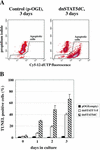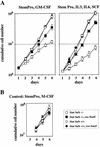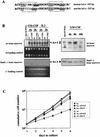Antiapoptotic activity of Stat5 required during terminal stages of myeloid differentiation
- PMID: 10652277
- PMCID: PMC316353
Antiapoptotic activity of Stat5 required during terminal stages of myeloid differentiation
Abstract
Stat5 is activated by multiple receptors of hematopoietic cytokines. To study its role during hematopoiesis, we have generated primary chicken myeloblasts expressing different dominant-negative (dn) alleles of Stat5. This caused a striking inability to generate mature cells, due to massive apoptosis during differentiation. Bcl-2 was able to rescue differentiating cells expressing dnStat5 from apoptosis, suggesting that during cytokine-dependent differentiation the main function of the protein is to ensure cell survival. Our findings with dnStat5-expressing chicken myeloblasts were confirmed with primary hematopoietic cells from Stat5a/Stat5b-deficient mice. Bone marrow cells from these animals displayed a strong increase in apoptotic cell death during GM-CSF-dependent functional maturation in vitro. The antiapoptotic protein Bcl-x was induced by GM-CSF and IL-3 in a Stat5-dependent fashion. Ectopic expression of Bcl-x rescued Stat5-deficient bone marrow cells from apoptosis, indicating that Stat5 promotes the survival of myeloid progenitor cells through its ability to induce transcription of the bcl-x gene. Finally, the recruitment of myeloid cells to inflammatory sites was found strongly impeded in Stat5-deficient mice. Taken together, our findings suggest that Stat5 may promote cytokine-dependent survival and proliferation of differentiating myeloid progenitor cells in stress or pathological situations, such as inflammation.
Figures







Similar articles
-
IL-3 dependent regulation of Bcl-xL gene expression by STAT5 in a bone marrow derived cell line.Oncogene. 1999 Jul 22;18(29):4191-9. doi: 10.1038/sj.onc.1202796. Oncogene. 1999. PMID: 10435632
-
Cooperative and redundant effects of STAT5 and Ras signaling in BCR/ABL transformed hematopoietic cells.Oncogene. 2001 Sep 13;20(41):5826-35. doi: 10.1038/sj.onc.1204549. Oncogene. 2001. PMID: 11593388
-
Cooperation between STAT5 and phosphatidylinositol 3-kinase in the IL-3-dependent survival of a bone marrow derived cell line.Oncogene. 2000 Feb 24;19(9):1164-72. doi: 10.1038/sj.onc.1203418. Oncogene. 2000. PMID: 10713704
-
The role of STATs in myeloid differentiation and leukemia.Oncogene. 2000 May 15;19(21):2511-22. doi: 10.1038/sj.onc.1203479. Oncogene. 2000. PMID: 10851050 Review.
-
The role of Ets family transcription factor PU.1 in hematopoietic cell differentiation, proliferation and apoptosis.Cell Death Differ. 1999 Jul;6(7):599-608. doi: 10.1038/sj.cdd.4400534. Cell Death Differ. 1999. PMID: 10453070 Review.
Cited by
-
Activated STAT5 proteins induce activation of the PI 3-kinase/Akt and Ras/MAPK pathways via the Gab2 scaffolding adapter.Biochem J. 2005 Aug 15;390(Pt 1):359-66. doi: 10.1042/BJ20041523. Biochem J. 2005. PMID: 15833084 Free PMC article.
-
STAT5 signaling is required for the efficient induction and maintenance of CML in mice.Blood. 2006 Jun 15;107(12):4917-25. doi: 10.1182/blood-2005-10-4110. Epub 2006 Mar 7. Blood. 2006. PMID: 16522816 Free PMC article.
-
Accumulation of FLT3(+) CD11c (+) dendritic cells in psoriatic lesions and the anti-psoriatic effect of a selective FLT3 inhibitor.Immunol Res. 2014 Oct;60(1):112-26. doi: 10.1007/s12026-014-8521-4. Immunol Res. 2014. PMID: 24895100
-
Signal transduction activator of transcription 5 (STAT5) dysfunction in autoimmune monocytes and macrophages.J Autoimmun. 2005 Jun;24(4):297-310. doi: 10.1016/j.jaut.2005.02.001. Epub 2005 Mar 23. J Autoimmun. 2005. PMID: 15927792 Free PMC article.
-
Granulocyte/macrophage colony-stimulating factor and accessory cells modulate radioprotection by purified hematopoietic cells.J Exp Med. 2005 Mar 21;201(6):853-8. doi: 10.1084/jem.20041504. J Exp Med. 2005. PMID: 15781578 Free PMC article.
References
-
- Barahmand-pour F, Meinke A, Eilers A, Gouilleux F, Groner B, Decker T. Colony-stimulating factors and interferon-gamma activate a protein related to MGF-Stat 5 to cause formation of the differentiation-induced factors in myeloid cells. FEBS Letters. 1995;360:29–33. - PubMed
-
- Bedi A, Sharkis SJ. Mechanisms of cell commitment in myeloid cell differentiation. Curr Opin Hematol. 1995;2:12–21. - PubMed
-
- Beug H, Leutz A, Kahn P, Graf T. Ts mutants of E26 leukemia virus allow transformed myeloblasts, but not erythroblasts or fibroblasts, to differentiate at the nonpermissive temperature. Cell. 1984;39:579–588. - PubMed
-
- Beug H, Blundell PA, Graf T. Reversibility of differentiation and proliferative capacity in avian myelomonocytic cells transformed by tsE26 leukemia virus. Genes & Dev. 1987;1:277–286. - PubMed
Publication types
MeSH terms
Substances
LinkOut - more resources
Full Text Sources
Molecular Biology Databases
Research Materials
Miscellaneous
